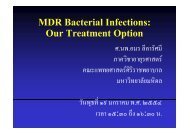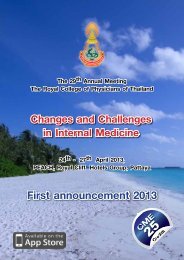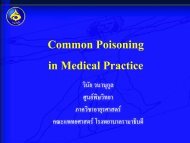7/18/2011 1 Clinical Use of Antiepileptic Drugs and Clinical Use of ...
7/18/2011 1 Clinical Use of Antiepileptic Drugs and Clinical Use of ...
7/18/2011 1 Clinical Use of Antiepileptic Drugs and Clinical Use of ...
You also want an ePaper? Increase the reach of your titles
YUMPU automatically turns print PDFs into web optimized ePapers that Google loves.
7/<strong>18</strong>/<strong>2011</strong>AEDs induce seizure• AEDs induce absence• phenytoin, carbamazepine,phenobarbital• AEDs induce myoclonic seizure• phenytoin, carbamazepineINDICATION FOR STARTINGANTIEPILEPTIC DRUG3132Indication for starting AED• Based on assessing consequence <strong>of</strong>epilepsy versus consequence <strong>of</strong> AED• Consider• How seizures interfere with• ability to function• quality <strong>of</strong> life• Perspective view <strong>of</strong> patient, family, societyConsequence <strong>of</strong> epilepsy depend on• Seizure type• Timing <strong>and</strong> frequency <strong>of</strong> attack• Age <strong>and</strong> condition <strong>of</strong> patients• Type <strong>of</strong> employment• Response <strong>of</strong> patient, family <strong>and</strong> society• Driving license3334All patients with epilepsy need Rx?• Average risk <strong>of</strong> having further seizure aftera first unprovoked seizure = 46%(Berg <strong>and</strong> Shinnar, Neurology 1991)• Risk <strong>of</strong> subsequent seizures after asecond seizure = more than 70%(Hauser et al, N Engl J Med 1998)35Recurrence risk factorsafter first seizure(++ strong, + weak)• With recurrence risk factor, risk <strong>of</strong>recurrence after a first seizure might besimilar to the average risk after twounprovoked seizure (Berg <strong>and</strong> Shinnar, Neurology 1991)• Known etiology ++• Epileptiform EEG ++• Family history: first degree relatives +• Time elapsed from seizure +• Todd’s paresis +366







